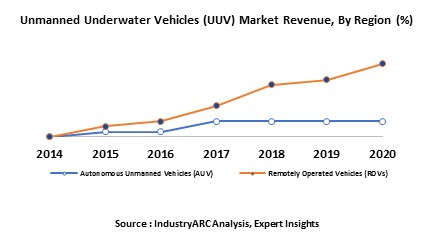There are two types of unmanned underwater vehicles which are Autonomous Underwater Vehicles and Remotely Operated Vehicles. The main difference is that AUV does not require continuous human interference or control and operates according to the pre-programmed instructions while the ROV is controlled continuously via an umbilical cord. Unmanned underwater vehicles (UUVs) are primarily used in defense and government operations, academic and scientific research, commercial activity and retrieval systems.

- To improve the ability of unmanned systems to communicate and operate between air, surface, and undersea domains is one important area of focus beyond developing larger UUVs. In a manner similar to manned ships and helicopters currently collaborating to locate and destroy sea mines, unmanned surface and undersea vehicles could be used to accomplish the same mission while keeping human operators at safe end. AeroVironment successfully achieved communication of its Blackwing UAV with a swarm of unmanned undersea vehicles recently and parallel to it Lockheed Martin also launched a UAV from a Marlin MK2 autonomous underwater vehicle successfully.
- The Navy and other DoD departments have allocated considerably more funds for the next generation UUV systems and technologies research. Defense funding for research into UUVs is around three times more than funds for procurement. The Large Displacement Unmanned Undersea Vehicle (LDUUV) and the Extra Large UUV (XLUUV) are the largest portions of these research programs.
-
- Hydronalix recently received a contract for an advanced research to for development of prototype mobile gateway buoys with integrated communications and control software from the Naval Air Warfare Center Aircraft Division. Hydronalix engineers are building an improved gateway buoy hull with hybrid electric and heavy-fuel propulsion, which integrates MK 18 gateway buoy communications equipment, and controlled by Neptune control software. The company will build two gateway buoy prototypes, and integrate them with control software and acoustic communication systems.
- Ability of USVs and UUVs systems to adapt intelligently to changes in their tactical situations is another important feature which is of prime importance. Improvements in the autonomous capabilities of these systems are crucial to their future development. There are changes expected in the tactical situations as the specific missions of these vehicles evolve and their onboard sensing systems will also continuously evolve indicating such changes. The onboard systems must be capable of recognizing the changes and adapting the mission plan accordingly, without the need for intervention by operators. Hence AI and ML concepts are being considered for OBEs.
- Evaluate market potential through analyzing growth rates (CAGR %), Volume (Units) and Value ($M) data given at country level – for product types, end use applications and by different industry verticals.
- Understand the different dynamics influencing the market – key driving factors, challenges and hidden opportunities.
- Get in-depth insights on your competitor performance – market shares, strategies, financial benchmarking, product benchmarking, SWOT and more.
- Analyze the sales and distribution channels across key geographies to improve top-line revenues.
- Understand the industry supply chain with a deep-dive on the value augmentation at each step, in order to optimize value and bring efficiencies in your processes.
- Get a quick outlook on the market entropy – M&A’s, deals, partnerships, product launches of all key players for the past 4 years.
- Evaluate the supply-demand gaps, import-export statistics and regulatory landscape for more than top 20 countries globally for the market.










Comments (0)
Post a Comment